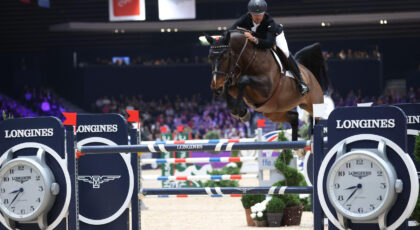“Often, the lessons I teach are not so different from the lower level to the higher level—it’s the expectations and technicality that vary,” says Canadian Equestrian Team veteran Jay Duke.
Duke made a name for himself as a competitor with a knack for developing young horses, but has since hung up his show coat to focus on teaching clinics throughout North America and expanding his subscription-based Virtual Lesson Program.
“When I teach a clinic, I ask every rider two questions: what’s your biggest struggle and what’s your biggest strength,” he continues. “From there, I try to get the most from that horse and rider and produce a positive result where both did something they didn’t think they were capable of doing.”
Here Duke shares an exclusive sneak peek at the Virtual Lesson Program his subscribers receive in their email inbox each week with “Roll, Roll, Rollbacks,” an intermediate-level lesson to help any horse and rider combination master the rollback.
Benefits for the Horse:
- Improve turns and suppleness
- Encourage balance and use of the hind end
- Help with landing the correct lead
Benefits for the Rider:
- Finding the distance with a balanced body off the turn
- Squaring corners and improving an eye
- Turning with two reins
Step 1: Assemble your materials
To start, you will need:
- 12 standards
- 12 rails (no ground lines)
- Fill is optional
Step 2: Set the jump heights
The heights can range from poles to 1.30m depending on the level of horses and riders.
Step 3: Warm it up
Use the entire ring and begin the lesson at the walk or trot, then progress to the canter. Riding with no stirrups is recommended when the fences are poles or low jumps for added difficulty and better feel of the horse’s body.
Step 4: Set up the approach
Begin on the right canter lead to fence 1. Land on the right lead and shape your horse out to the rail to create a good approach to fence 2.
Step 5: Roll
Take three canter strides from fence 2 to fence 3 while holding the right canter lead. Land the right lead and create a correct rollback turn to fence 4.
What’s a correct rollback? This involves getting to the corner after the jump, coming out of the corner on a straight track to the jump, and doing all this with the correct shape of the horse’s bend and frame.
Step 6: Keep on rolling!
Using all the space available, rollback to fence 5 and take three canter strides to fence 6 while holding the right lead.
Step 7 (optional): Keep it going
Continue with a right lead rollback to fence 1 and start again.
Don’t forget to practice both leads equally!
Click the image above to print a copy of the Roll, Roll, Rollbacks lesson plan.
Learn more about the Jay Duke Equestrian Lesson Library at jayduke.com. A portion of all lesson subscription proceeds will be donated to beneficiary charities JustWorld International and Uryadi’s Village.
About the Author
Jay Duke is a show jumping rider, course designer, clinician, and Canadian Equestrian Team veteran who has represented his country in Nations’ Cup competition in Washington, New York, and Toronto. A four-time Canadian Junior Champion as well as Leading Rider at the Spruce Meadows “North American” tournament, Jay has an extensive background with horses of all levels and breeds. For more information about Jay, visit jayduke.com.




 October 10, 2018
October 10, 2018 





























